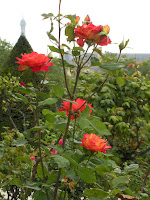Rodin, the great 19th century sculptor, had his studio in the Hôtel Biron, an 18th century mansion built by a man who made his fortune from wigs. By Rodin's time, the mansion had been divided into individual apartments, one of which Rodin used to showcase his large-scale sculptures. He agreed to leave the greater part of his works to the State if the Biron mansion was turned into a museum to house them. This was done, and today the public can view both his works and those of his lover, Camille Claudel, inside the museum. The real draw, however, is the gardens, where Rodin's most famous pieces can be found and which cost only 1 Euro to enter!

Hôtel Biron
The first thing we see when we enter the garden is a statue I think we'll all recognize - Le Penseur.
The Thinker

A view of the dome of L'Eglise St. Louis, under which Napoleon is buried. Interestingly, there is a large space between the interior and exterior domes where French Resistance fighters hid Allied pilots who had crash-landed in Occupied France during WWII.

A view of the dome of L'Eglise St. Louis, under which Napoleon is buried. Interestingly, there is a large space between the interior and exterior domes where French Resistance fighters hid Allied pilots who had crash-landed in Occupied France during WWII.
Crossing to the left, we come upon the huge piece called Les Portes d'Enfer. We're excited to see it, not just for the detail on the piece, but also because we just saw the mold for the work in the Musée d'Orsay.
The Gates of Hell

Detail from The Gates of Hell... Recognize him?

Detail from The Gates of Hell... Recognize him?
The next piece we come to is Les Burghers de Calais. This piece was commissioned by the town of Calais to commemorate the six brave men who surrendered themselves to the invading English during the Hundred Years' War in order to save the lives of their townspeople

The Burghers of Calais

The Burghers of Calais
Now, let's admire the actual gardens themselves. Looking around, we're amazed by how all of this greenery and lushness is hidden in the middle of the city, behind great walls. If we didn't know better, we could never imagine what was hidden here. It makes me wonder what's behind all the other great walls I pass on a regular basis in this town.
Finally, we find the statue of Balzac in a little corner of the garden. We saw the mold for this one at Orsay the other day. There's something about him that is a bit unsettling, a bit too grand. I think Rodin was trying to capture more of the greatness of Balzac's work than of the man, himself. I mean, he did write La Comedie Humaine.
That's it for the garden. We could have spent hours there, but we had a dinner to cook. More on that later...
... And their fruit! Maybe we'll follow in Karen's footsteps and forage some to roast at home.
Finally, we find the statue of Balzac in a little corner of the garden. We saw the mold for this one at Orsay the other day. There's something about him that is a bit unsettling, a bit too grand. I think Rodin was trying to capture more of the greatness of Balzac's work than of the man, himself. I mean, he did write La Comedie Humaine.
That's it for the garden. We could have spent hours there, but we had a dinner to cook. More on that later...












No comments:
Post a Comment